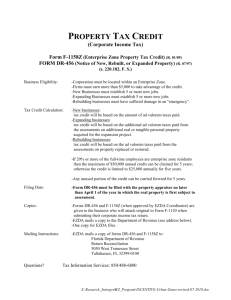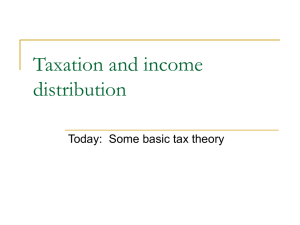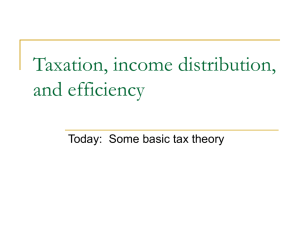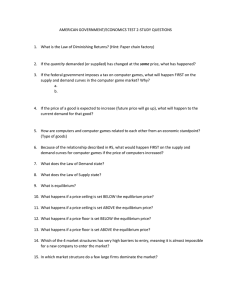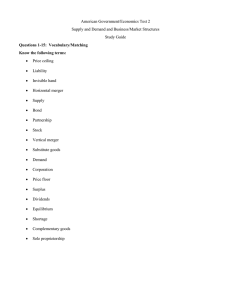WARWICK ECONOMIC RESEARCH PAPERS Unit Versus Ad Valorem Taxes:
advertisement
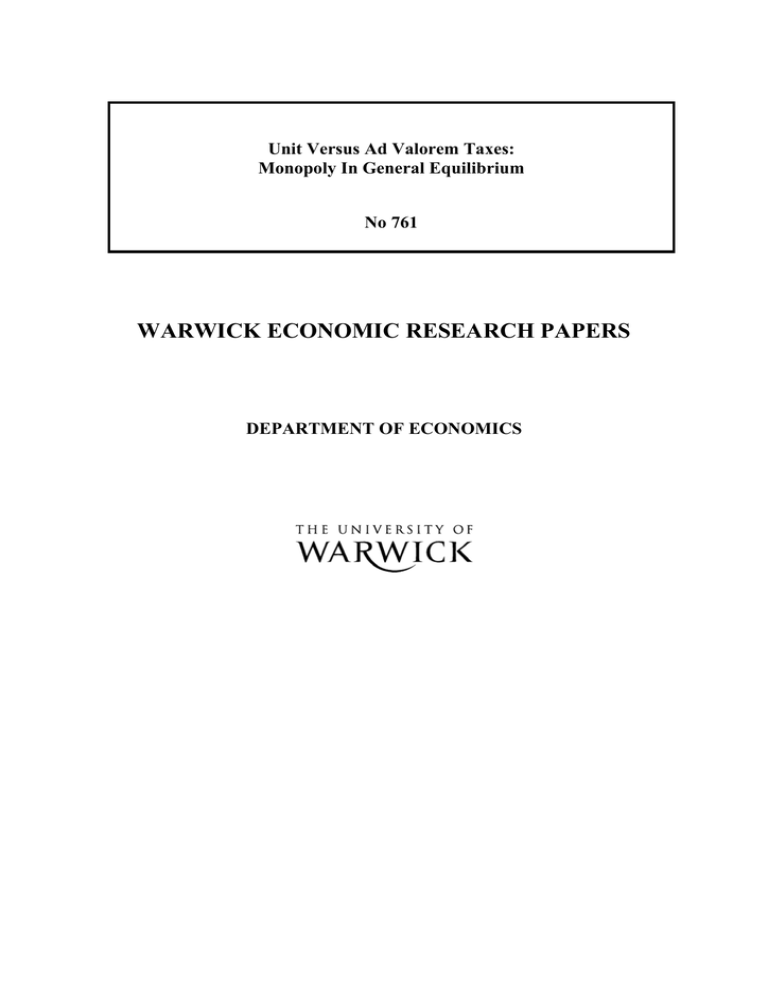
Unit Versus Ad Valorem Taxes:
Monopoly In General Equilibrium
No 761
WARWICK ECONOMIC RESEARCH PAPERS
DEPARTMENT OF ECONOMICS
Unit Versus Ad Valorem Taxes: GE.Monopoly.100 % Profit Tax
Unit Versus Ad Valorem Taxes:
Monopoly In General Equilibrium*
Charles Blackorby and Sushama Murty
February 2006
Charles Blackorby: Department of Economics, University of Warwick and GREQAM,
c.blackorby@warwick.ac.uk
Sushama Murty: Department of Economics, University of Warwick,
s.murty@warwick.ac.uk
* We thank Ben Lockwood and Alain Trannoy for discussions and comments.
October 1, 2006
Unit Versus Ad Valorem Taxes: GE.Monopoly.100 % Profit Tax
Abstract
We show that if a monopoly sector is imbedded in a general equilibrium framework and
profits are taxed at one hundred percent, then unit (specific) taxation and ad valorem
taxation are welfare-wise equivalent. This is contrary to all known claims. Journal of
Economic Literature Classification Number:H21
Keywords: Ad valorem taxes, unit taxes, monopoly.
Unit Versus Ad Valorem Taxes: GE.Monopoly.100 % Profit Tax
Unit Versus Ad Valorem Taxes—Monopoly In General Equilibrium
by
Charles Blackorby and Sushama Murty
1. Introduction
It is well-known that, in a competitive environment, unit (or specific) taxation and ad
valorem taxation are equivalent. Cournot [1838, 1960] realized that the two tax systems
needed different treatment in the case of monopoly. Wicksell [1896, 1959] argued that
ad valorem taxes dominate unit taxation in a monopoly; a complete demonstration of
this dominance was given by Suits and Musgrave [1955]. More specifically they demonstrated, if the consumer price and quantity of the monopoly good remained unchanged,
that the government tax yield is higher with ad valorem taxes than under a regime of
unit taxes. This follows because the profit-maximizing price of the monopolist is lower
under ad valorem taxation than under unit taxation. Most recent work in this area has
investigated forms of competition between pure monopoly and competition implicitly or
explicitly accepting the above dominance argument. Delipalla and Keen [1992] examine
different models of oligopoly with and without free entry to compare the two types of tax
regimes while Lockwood [2004] shows, in a tax competition model, that tax competition
is more intense with ad valorem taxes thus yielding a lower price in equilibrium.
Wicksell and Suits and Musgrave derived the above mentioned monopoly result in
a partial equilibrium framework and claimed that ad valorem taxation was superior to
unit taxation on welfare grounds. Recently, stronger and more explicit claims have been
made: Skeath and Trandel [1994; p. 55] state that “in the monopoly case, given any unit
excise tax, it is possible to find an ad valorem tax that Pareto dominates it.”; Keen [1996;
p. 9] states that “The conclusion—due to Skeath and Trandel [1994]—is thus strikingly
unambiguous: with monopoly provision of a single good of fixed quality, consumers prefer
ad valorem taxation because it leads to a lower price, firms prefer it because it leads
to higher profits and government prefers it because it leads to higher revenue. There is
no need to trade off the interests of these three groups: ad valorem taxation dominates
specific.”
It is this claimed welfare dominance of ad valorem taxes over unit taxation that
we challenge in this paper. In the context of a general equilibrium model with a single
monopoly sector, we prove that unit and ad valorem taxation are equivalent.
More specifically, we take a standard general equilibrium model in which a single
monopoly sector has been imbedded.1 In particular we adapt the model of Guesnerie
and Laffont [1978] (hereafter GL) to pose this question. In order to study alternative tax
schemes it must be the case that indirect taxation is an optimal instrument; we permit
the government to employ a demogrant, a transfer (positive or negative) that is common
1 Our results hold for any symmetric Cournot oligopoly as well.
1
Unit Versus Ad Valorem Taxes: GE.Monopoly.100 % Profit Tax
to all consumers rather than individual lump-sum transfers. In addition, we need to
decide how to treat the profits of the competitive and monopoly sector. The government
can either levy one hundred percent profit taxation or the profits can be rebated to the
individual consumers in proportion to the shares held in the companies. It is common
in public economics to adopt the former assumption as it is usually an innocuous but
simplifying assumption;2 we follow this tradition here because it seems closest to the
analysis of the partial equilibrium models whose results we challenge. In order for partial
equilibrium models to be consistent with utility maximization, quasi-linear preferences are
required and this means that the relevant demands are independent of the distribution of
income.3 Assuming one hundred percent taxation of profits is the closest that one can
come to avoiding income effects in a general equilibrium framework. Nevertheless, this
assumption does have strong implications and in our concluding remarks we discuss some
of the additional problems that arise if monopoly profits are privately distributed. It should
be noted however that if private ownership of the firms makes a substantial difference, it
is because of income effects and the partial equilibrium models cannot cannot handle such
changes in any case.
We first characterize the set of Pareto optima in the economy with unit taxation.
We then convert each Pareto-optimal unit-tax equilibrium into an equivalent ad valorem
tax equilibrium and ask if there exist any feasible ad valorem tax Pareto improvements
from this equilibrium. We show that there none. We then reverse this procedure and
characterize the set of Pareto optima with ad valorem taxes, convert these equilibria to
unit tax equilibria, and then show that there are no possible Pareto improvements using
unit taxes. Thus, we prove that ad valorem and unit taxation are equivalent. The set of
Pareto optima under unit taxes is identical to the set of Pareto optima under ad valorem
taxation.
The reasons that our results are in striking contrast to the literature are two-fold.
The partial equilibrium problem analyzed by Wicksell and Suits-Musgrave ignores that,
although tax revenues go up in the switch to ad valorem taxes, the profits of the monopolist go down. In a general equilibrium framework this reduction in profit must show up
somewhere else. With one hundred percent taxation this simply means that government
revenue from profit taxation goes down by the same amount that its revenue from indirect taxes went up. The surplus analysis of Skeath and Trandel arrives at an incorrect
conclusion because the criteria they use do not translate into improvements in the sense
of Pareto.4
2 A common alternative assumption is constant return-to-scale which simply eliminates profits; this
will not work here because of the monopoly sector.
3 See Chipman and Moore [1976] and Silverberg [1972].
4 This is not surprising given these surplus arguments have already been shown to perform rather
badly in both competitive and non competitive environments; see Blackorby and Donaldson [1985,1999].
However, even in the quasi-linear case, when most surplus arguments do work, the aggregate surplus is
independent of the distribution of wealth. In this problem it is the distribution of wealth that is of crucial
importance and ignoring it can lead to errors.
2
Unit Versus Ad Valorem Taxes: GE.Monopoly.100 % Profit Tax
In the next section we introduce the notation, in the following we characterize the set
of unit tax Pareto optima after which we convert the Pareto-optimal unit-tax equilibria
into ad valorem equilibrium. In the following section we show that all such ad valorem
equilibrium are also Pareto optimal. We reverse this procedure and show that ad valorem
and unit taxation are equivalent.
2. Notation
The preferences of each of the H consumers are represented by an indirect utility function,
uh = V h (q0 , q, m) for h = 1, . . . , H
(2.1)
where q0 ∈ R++ is the consumer price of the monopoly good, q ∈ RN
++ is the vector
of consumer prices of the competitively supplied goods. The demogrant—a transfer that
is common to all consumers—is given by m.5 V h is assumed to be twice continuously
differentiable and strongly quasi-convex.6 The demands are given by Roy’s Theorem and
the aggregate demand for the monopoly good is
(2.2)
x∗h0 = x∗0 (q0 , q, m)
x0 =
h
and the aggregate demand vector for the competitively supplied commodities is given by
x=
xh (q0 , q, m)
(2.3)
h
The consumer prices and producer prices are related by unit taxes, that is, q0 = p0 +t0 and
q = p + t, where p0 and p are the producer prices of the monopoly good and competitive
goods respectively. The unit tax on the monopoly good and the competitive goods are t0
and t respectively.
As discussed in detail in GL the profit function of the monopolist (the function over
which he optimizes) is not in general concave. Following them we assume that the solution to monopolist’s profit maximization problem is locally unique and smooth. For the
monopoly let
P0u (p, t0 , t, m), Y0u (p, t0 , t, m) :=
argmaxpu0 ,y0u {p0 y0u − C(y0u , p)|y0u ≥ x∗0 (q0 , q, m)},
(2.4)
where the cost function of the monopolist is assumed to be differentially strongly concave.7
We assume that P0u is single-valued and smooth and as in GL that
∇t0 P0u = −1;
(2.5)
5 There is also a public good g but, as it remains constant throughout the analysis, it is suppressed in
the utility function.
6 See Diewert, Avriel and Zang [1981].
7 See Avriel, Diewert, Schaible, and Zang [1988].
3
Unit Versus Ad Valorem Taxes: GE.Monopoly.100 % Profit Tax
that is, the monopolist cannot undo all changes by the tax authority of t0 . The input
demands by the monopolist from the competitive sector is given by
y m = ∇p C(y0u , p).
(2.6)
Monopoly profit with unit taxation is given by
Πmu (pu0 , p, y0u ) = pu0 y0u − pT ∇p C(y0u , p) = pu0 y0u − C(y0u , p).
(2.7)
The profit function of the competitive sector Πc is assumed to be strongly convex and
twice continuously differentiable.8 Applying Hotelling’s Lemma it can be re-written as
Πc (p) = pT y c (p).
(2.8)
rank [ ∇p y c (p) − ∇p y m (p) ] = N − 1.
(2.9)
In addition we assume that
This ensures that the zero eigenvector is unique up to a positive scalar multiple.9 In
addition the government produces a public good g from inputs y g purchased from the
competitive sector by
g ≤ F (y g );
(2.10)
we assume that F is increasing and differentially strongly concave.
Equilibrium in this unit-tax economy is given by
−x + y c − y m − y g ≥ 0,
(2.11)
−x∗0 (q0 , q, m) + y0u ≥ 0,
(2.12)
pu0
(2.13)
− P0u (p, t0 , t, m)
= 0,
and
F (y g ) − g ≥ 0.
(2.14)
(2.11) is market clearing for the competitively produced commodities, (2.12) is market
clearing for the monopoly good, and (2.13) ensures that the monopolist is profit maximizing
whereas (2.14) requires the public-good producing firm to buy enough inputs to produce
the fixed amount of the public good.
Given that the indirect utility functions are increasing in income, the budget constraints of all the consumers are binding at their optimal bundles. In addition, if the
equilibrium conditions hold as equalities then from Walras Law it follows that the demogrant is
1 mu u
u
T
c
T g
Π (p0 , p, y0 ) + t x + t0 y0 + Π (p) − p y .
(2.15)
m=
H
8
See Avriel, Diewert, Schaible, and Zang [1988]. The assumption of a single competitive firm is
without loss of generality; see Bliss [1975].
9 In fact our regularity assumptions already guaranty this to be true almost everywhere.
4
Unit Versus Ad Valorem Taxes: GE.Monopoly.100 % Profit Tax
This is because aggregating over consumer budgets and using the equilibrium conditions,
(2.11) and (2.12), we obtain
Hm = q0 x∗0 + q T x
≤ (pu0 + t0 )y0u + (p + t)T [y c − y m − y g ]
= pu0 y0u − pT y m + pT y c + tT [y c − y m − y g ] − pT y g
(2.16)
= Πmu (pu0 , p, y0u ) + tT [y c − y m − y g ] + t0 y0 + Πc (p) − pT y g .
Thus, at an equilibrium where (2.11) and (2.12) hold as equalities, the government budget
just balances, i.e., the revenue of the government from indirect and profit taxation, net of
its expenditure on the public good, gets distributed as the demogrant to the consumers.
3. Unit-Tax Pareto Optima
In order to characterize the set of Pareto optima with unit taxation, we assume first
that the equilibrium conditions, (2.11)-(2.14) hold with equality. From this equilibrium
we calculate the directions of change in prices, taxes, and demogrant that could generate
strict Pareto improvements,10 preserve equilibrium, and ensure that the monopolist is
maximizing profit and the public good producer can buy sufficient inputs to produce the
public good.11 If no such changes exist then the equilibrium with which we started is a
Pareto optimum.
Assume that the equilibrium conditions, (2.11)-(2.14), hold with equality. Then,
there exist strict Pareto-improving directions of change that are equilibrium-preserving
and provide for the production of the public good if and only if
u
dp0
dt0
1
1
1T
1T
T
−x0 −x0 −x
−x
1 0N 0 dp
.
..
..
..
..
..
(3.1)
..
.
.
.
.
.
dt 0
−xH
−xH
−xHT −xHT 1 0TN 0 dm
0
0
dy g
dy0u
10 That is, changes that increase the utility of every consumer.
11 Walras Law ensures that, at the new equilibria reached by such directions of change, the government’s
budgets are always balanced in the sense of (2.16).
5
Unit Versus Ad Valorem Taxes: GE.Monopoly.100 % Profit Tax
and
−∇q0 x
−∇ x
q0 0
0
−∇q0 x
−∇q x + ∇p y c − ∇p y m
−∇q x
−∇m x
−IN
−∇y0u y m
−∇q0 x0
−∇Tq x0
−∇Tq x0
−∇m x0
0TN
1
0
0TN
0TN
0
∇Tyg F
0
u
dp0
dt0
dp
dt ≥ 0.
dm
dy g
dy0u
(3.2)
That the monopolist continues to maximize profits after the changes is guaranteed by
u
dp0
dt0
dp
1 −∇t0 P0u −∇Tp P0 −∇Tt P0 −∇m P0u 0TN 0
(3.3)
dt = 0.
dm
dy g
dy0u
If there exists a vector (dpu0 , dt0 , dp, dt, dm, dy g , dy0u ) that satisfies (3.1)-(3.3), then
the equilibrium in question is not a Pareto optimum because there are feasible changes in
prices and quantities that make every individual better off. If there are no such feasible
changes, then the equilibrium is a Pareto optimum. In order to characterize the set of all
unit-tax Pareto optima, we employ Motzkin’s Theorem.12
We are at a Pareto optimum, that is, there is not solution to (3.1)-(3.3), if and only
if there exist 0 = s̄ ≥ 0, (v̄0 , v̄ T ) ≥ 0, r̄ ≥ 0 and β̄, such that
s̄h x̄h0 = −v̄ T ∇q0 x̄ − v̄0 ∇q0 x̄0 + β̄,
(3.4)
h
h
s̄h x̄h0 = −v̄ T ∇q0 x̄ − v̄0 ∇q0 x̄0 − β̄∇t0 P̄0u ,
(3.5)
s̄h x̄hT = −v̄ T ∇q x̄ + v̄ T [∇p ȳ c − ∇p ȳ m ] − v̄0 ∇Tq x̄0 − β̄∇Tp P̄0u ,
(3.6)
h
s̄h x̄hT = −v̄ T ∇q x̄ − v̄0 ∇Tq x̄0 − β̄∇Tt P̄0u ,
(3.7)
h
12 Motzkin’s Theorem states that either Ax 0, Bx ≥ 0, and Cx = 0 has a solution or sT A + v T B +
wT C = 0, where 0 = s ≥ 0 and v ≥ 0 has a solution but not both. See Mangasarian [1969] for a formal
statement and proof.
6
Unit Versus Ad Valorem Taxes: GE.Monopoly.100 % Profit Tax
s̄h = v̄ T ∇m x̄ + v̄0 ∇m x̄0 + β̄∇m P̄0u ,
(3.8)
h
v̄ T = r̄∇Tyg F̄ ,
(3.9)
v̄ T ∇y0u ȳ m = v̄0 .
(3.10)
and
This system of equations, (3.4)-(3.10), characterizes all possible unit-tax Pareto optima.13 However, the system can be simplified considerably as follows.
First, subtract (3.5) from (3.4), and then using (2.5) we obtain β̄ = 0.14 Next,
subtract (3.7) from (3.6) to obtain
v̄ T [∇p ȳ c − ∇p ȳ m ] = 0.
(3.11)
The rank condition, (2.9), guarantees that the zero eigenvector of [∇p ȳ c − ∇p ȳ m ] is unique
up to positive scalar multiplication. Thus (3.11) implies that
v̄ T = µ̄p̄T .
(3.12)
Then (3.9) implies in conjunction with (3.12), that
p̄T µ̄ = r̄∇Tyg F̄ ,
(3.13)
which implies that there is production efficiency in the production of competitive goods
in the economy. The competitive firms face prices p̄ and the monopolist buys inputs from
that sector at prices p̄. From (3.13) we see that
Fi (ȳ g )
p̄i
=
p̄j
Fj (ȳ g )
for i, j = 1, . . . , N,
(3.14)
so that the public sector firm is setting its marginal rates of transformation equal to the
ratios of producer prices of the competitive goods. Also, from (3.10) and (3.12), we have
µ̄∇y0u C̄ = v̄0 ,
(3.15)
that is, the marginal cost of the monopolist is proportional to the social shadow price v̄0
(the shadow price that would have prevailed under public production of the monopoly
good.) Thus, overall production efficiency is implied by (3.13) and (3.15).
13 Note that we employ some abbreviations: C̄ = C(ȳ u , p̄); F̄ = F (ȳ g );Π̄c = Πc (p̄).
0
14 This is analogous to results in GL and shows that the constraint requiring the monopolist to maximize
profits is not binding. This means that in searching for a Pareto optimum the planner can do no better
than use the monopoly power itself because it levies one hundred per cent profit taxes and can rebate
these profits to the consumers as a demogrant. Alternatively, the monopoly constraint not binding implies
that if we were to endow production of the monopoly good to the public sector (which means no price
making behavior or any behavioral constraint in the production of that good), then the public sector firm
does no better than the monopolist.
7
Unit Versus Ad Valorem Taxes: GE.Monopoly.100 % Profit Tax
To summarize the equations characterizing a unit-tax Pareto optimum, (3.4)-(3.10),
can be rewritten using β̄ = 0 and (3.13) as
s̄h x̄h0 = −µ̄p̄T ∇q0 x̄− v̄0 ∇q0 x̄0 ,
(3.16)
h
s̄h x̄hT = −µ̄p̄T ∇q x̄ − v̄0 ∇q x̄0 ,
(3.17)
h
s̄h = µ̄p̄T ∇m x̄ + v̄0 ∇m x̄0 ,
(3.18)
h
p̄T = r̄
∇yg F̄
,
µ̄
(3.19)
v̄0
,
µ̄
(3.20)
and
p̄T ∇y0u C̄ =
where 0 = s̄ ≥ 0, (v̄0 , v̄ T ) ≥ 0, and r̄ > 0.
4. Unit Tax Equilibrium as an Ad Valorem Tax Equilibrium.
First, we convert an arbitrary unit-tax equilibrium into an equivalent ad valorem tax
equilibrium. A monopoly ad-valorem tax equilibrium with 100% taxation of all profits and
redistribution of governmental revenue as a demogrant, R, is given by
−x(q, q0 , R) + y c (p) − y m (p, y0a ) − y g ≥ 0,
(4.1)
−x0 (q0 , q, R) + y0a ≥ 0,
(4.2)
pa0 − P0a (τ0 , p, τ, R) = 0, and
(4.3)
F (y g ) − g ≥ 0.
(4.4)
where
q0 = (1 + τ0 )pa0 ,
q = (IN + τ )p,
and
P0a (p, τ0 , τ, R), &Y0a (p, τ0 , τ, R) :=
argmaxpa0 ,y0a {pa0 y0a − C(y0a , p)y0a ≥ x0 (pa0 (1 + τ0 ), pT (IN + τ ), R)}.
(4.5)
(4.6)
Proceeding as in (2.16), Walras’ law and the equilibrium conditions (4.1) to (4.3)
(when they hold as equalities) imply that15
Πma + Πc + τ T px + τ0 pa0 x0 − pT y g = HR,
(4.7)
Πma + Πc + τ T p[y c − y m − y g ] + τ0 pa0 y0a − pT y g = HR,
(4.8)
or
15 Note that p is the vector p diagonalized to be a matrix. Similarly, τ is a diagonalized version of τ .
8
Unit Versus Ad Valorem Taxes: GE.Monopoly.100 % Profit Tax
where
Πma (pa0 , p, y0a ) = pa0 y0a − C(y0a , p).
(4.9)
Now, consider any unit-tax Pareto optimal equilibrium with 100% taxation of all
profits and redistribution of governmental revenue as a demogrant p̄u0 , t̄0 , p̄, t̄, ȳ g , ȳ0u , m̄
characterized by
(4.10)
−x̄ + ȳ c − ȳ m − ȳ g ≥ 0,
−x̄0 (q̄0 , q̄, m̄) + ȳ0u ≥ 0,
(4.11)
p̄u0 − P0u (p̄, t̄0 , t̄, m̄) = 0,
(4.12)
F (ȳ g ) − g ≥ 0.
(4.13)
and
The consumer prices are given by q̄ = t̄ + p̄ and q̄0 = t̄0 + p̄u0 .
In order to represent it as an ad valorem tax equilibrium, we define τ̄ , τ̄0 , p̄a0 , ȳ0a , R̄ as
follows:
(i) τ̄ = t̄T p̄−1 so that q̄ = (IN + τ̄τ )p̄;
(ii) R̄ = m̄;
and
(iii) ȳ0a , τ̄0 , and p̄a0 solve
p̄a0 (1 + τ̄0 ) = q̄0 ,
p̄a0 = P0a (p̄, τ̄0 , τ̄ , R̄),
(4.14)
ȳ0a = Y0a (p̄, τ̄0 , τ̄ , R̄).
From this it follows that
x(pu0 + t̄0 , p̄ + t̄, m̄) = x(p̄a0 (1 + τ̄0 ), p̄T (IN + τ̄τ ), R̄)
(4.15)
x0 (p̄u0 + t̄0 , p̄ + t̄, m̄) = x0 (p̄a0 (1 + τ̄0 ), p̄T (IN + τ̄τ ), R̄)
(4.16)
and
so that
ȳ0a = ȳ0u =: ȳ0 and
(4.17)
∇p C(ȳ0 , p̄) = ȳ m .
From the above definitions and (2.15), it follows that
Πma + Πc + τ̄ T p̄[ȳ c − ȳ m − ȳ g ] + τ̄0 p̄a0 ȳ0 − p̄T ȳ g
= p̄a0 ȳ0 + τ̄0 p̄a0 ȳ0 − C(ȳ, p̄) + Πc + τ̄ T p̄[ȳ c − ȳ m − ȳ g ] − p̄T ȳ g
= p̄a0 (1 + τ0a )ȳ0 − C(ȳ, p̄) + Πc + t̄T [ȳ c − ȳ m − ȳ g ] − p̄T ȳ g
=
(p̄u0 + t̄u0 )ȳ0
mu
c
=Π
c
T
c
m
g
T g
− C(ȳ, p̄) + Π + t̄ [ȳ − ȳ − ȳ ] − p̄ ȳ
+ Π + t̄[ȳ c − ȳ m − ȳ g ] + t̄0 ȳ0 − p̄ȳ g
= H m̄ = H R̄.
9
(4.18)
Unit Versus Ad Valorem Taxes: GE.Monopoly.100 % Profit Tax
Thus, the above defined τ̄ , τ̄0 , p̄a0 , ȳ0a , R̄ solve (4.1) to (4.9) and hence they define a
monopoly ad-valorem tax equilibrium with 100% taxation of all profits and redistribution
of governmental revenue as a demogrant. Hence, the Pareto optimal unit tax equilibrium
described by (4.10) to (4.13), can also be interpreted as an ad valorem tax equilibrium.
Although we know that this is an ad valorem-tax equilibrium, we do not know if it
is Pareto optimal with respect to ad valorem tax changes. In order to accomplish this, we
assume that the inequalities in the ad valorem equilibrium, (4.1) to (4.6) hold with equality
and ask if there exist ad valorem Pareto-improving, equilibrium-preserving directions of
change. If there are no such changes, then every unit-tax Pareto optimum is also an ad
valorem-tax Pareto optimum.
The instruments under the control of the tax authority are given by ν = dpa0 ,
dτ0 , dp, dτ, dR, dy g , dy0a , and must be chosen so that ν is Pareto improving, equilibrium
preserving, ensures that wealth continues to be distributed in equal proportion, that the
monopolist is maximizing profit, and that the requisite amount of the public good is being
produced.
ν is a Pareto-improving direction of change if and only if
−x̄10 (1 + τ̄0 ) −x̄10 pa0 −x̄1T (IN + τ̄τ ) −x̄1T p̄ 1 0TN 0
..
..
..
..
..
..
..
(4.19)
. ν 0;
.
.
.
.
.
.
H a
−x̄H
0 (1 + τ̄0 ) −x̄0 p0
−x̄HT (IN + τ̄τ ) −x̄HT p̄ 1 0TN
0
ν is an equilibrium-preserving direction of change that guarantees the production of
the public good if and only if
(4.20)
[ Ma Na ] ν ≥ 0
where
−∇q0 x̄(1 + τ̄0 ) −∇q0 x̄pa0
M a = −∇q0 x̄0 (1 + τ̄0 ) −∇q0 x̄0 pa0
0
0
−∇q x̄(IN + τ̄τ ) + [∇p ȳ c − ∇p ȳ m ] −∇q x̄p̄
−∇Tq x̄0 (IN + τ̄τ )
−∇Tq x̄0 p̄
0TN
0TN
(4.21)
and
−∇R x̄
−∇ x̄
a
N =
R 0
0
−IN
0TN
∇Tyg F
−∇y0 ȳ m
1
;
0
(4.22)
and ν is an ad valorem tax profit-maximizing preserving directions of change if and only
if
(4.23)
1 −∇τ0 P̄0a −∇p P̄0a −∇τ P̄0a −∇R P̄0a 0TN 0 ν = 0.
If there exist Pareto-improving equilibrium-preserving directions of change that satisfy the above, then ad valorem taxation Pareto dominates unit taxation. However, if
there do not exist such directions of change then every unit tax Pareto optimum is also
an ad valorem tax Pareto optimum. In fact, we show that the converse is true as well.
10
Unit Versus Ad Valorem Taxes: GE.Monopoly.100 % Profit Tax
Theorem A: If there is complete taxation of all profits–both monopoly and the competitive
sector–and if government revenue is rebated equally by means of a demogrant, then every
unit-tax Pareto optimum is also an ad valorem-tax Pareto optimum and conversely.
Proof: Using Motzkin’s Theorem, there are no ad valorem directions of change satisfying
(4.19) to (4.23) at the unit-tax optimum if and only if there exist 0 = s̃T ≥ 0, (ṽ0 , ṽ T ) ≥ 0,
β̃, and r̃ ≥ 0 such that
s̃h x̄h0 (1 + τ̄0 ) = −ṽ T ∇q0 x̄(1 + τ̄0 ) − ṽ0 ∇q0 x̄0 (1 + τ̄0 ) + β̃,
(4.24)
h
s̃h x̄h0 pa0 = −ṽ T ∇q0 x̄pa0 − ṽ0 ∇q0 x̄0 pa0 − β̃∇q0 P̄0a ,
(4.25)
h
s̃h x̄hT (IN + τ̄τ ) = −ṽ T ∇q x̄(IN + τ̄τ ) + ṽ T [∇p ȳ c − ∇p ȳm ] − ṽ0 ∇Tq x̄0 (IN + τ̄τ ) − β̃∇p P̄0a ,
h
h
(4.26)
s̃h x̄
hT
p̄ = −ṽ
T
∇q x̄p̄ − ṽ0 ∇q x̄0 p̄ − β̃∇τ P̄0a ,
s̃h = ṽ T ∇R x̄ + ṽ0 ∇R x̄0 + β̃∇R P̄0a ,
(4.27)
(4.28)
h
ṽ T = r̃∇Tyg F̄ ,
(4.29)
ṽ T ∇y0 ȳ m = ṽ0 .
(4.30)
and
Suppose then that (4.24)-(4.30) have a solution with 0 = s̃ ≥ 0, (ṽ0 , ṽ) ≥ 0, β̃ and
r̃ ≥ 0. If this turns out to be correct then there are no ad valorem Pareto-improving
equilibrium-preserving directions of change. If this assumptions leads to a contradiction
then such changes exist and in that case ad valorem taxation would dominate unit taxation
in this model. We first simplify (4.24)-(4.30) as follows.
First multiply (4.24) by p̄a0 and (4.25) by 1 + τ̄0 and then subtract (4.25) from (4.24)
to obtain
(4.31)
β̃(p̄a0 + (1 + τ̄0 )∇τ0 P̄0a ) = 0.
Assuming that the monopolist cannot undo all taxes, (2.5), we have p̄a0 +(1+ τ̄0 )∇τ0 P̄0a = 0,
which implies that β̃ = 0.16
Next multiply (4.26) by [IN + τ̄τ ]−1 and subtract (4.27) from (4.26) after multiplying
(4.27) by p̄−1 to obtain after some manipulation
ṽ T [∇p ȳ c − ∇p ȳ m ] = 0
(4.32)
16 The consumer price, q̄ , is locally constant, q̄ = (1+τ̄ )P̄ a . Hence, dq = 0 implies p̄a +(1+τ̄ )∇ P̄ a =
0
0
0
0
τ̄0 0
0
0
0.
11
Unit Versus Ad Valorem Taxes: GE.Monopoly.100 % Profit Tax
which in turn implies, using the rank condition, that
ṽ T = µ̃p̄T .
(4.33)
Now substitute (4.33) into (4.29) to obtain
p̄T = r̃
∇yg F̄
µ̃
(4.34)
which shows that there is production efficiency in the competitive sector. Using (4.33), we
can rewrite (4.30) as
µ̃T ∇y0 C̄ = ṽ0 .
(4.35)
(4.35) together with (4.34) establishes overall production efficiency.
Using β̃ = 0 and (4.33) we can rewrite (4.24)-(4.30) as
s̃h x̄h0 = −µ̃p̄T ∇q0 x̄ − ṽ0 ∇q0 x̄0 ,
(4.36)
h
h
s̃h x̄hT = −µ̃p̄T ∇q x̄ − ṽ0 ∇q x̄0 ,
s̃h = µ̃p̄T ∇R x̄ + v̄0 ∇R x̄0 ,
(4.37)
(4.38)
h
p̄T = r̃
∇yg F̄
,
µ̃
and
∇y0 C̄ =
v̄0
.
µ̃
(4.39)
(4.40)
If (4.36)-(4.40) have a solution satisfying the non-negativity and semi-positivity conditions stated at the beginning of the proof, then there are no ad valorem feasible Pareto
improving directions of change and hence the unit tax Pareto optimum that we began with
is also an ad valorem Pareto optimum.
Looking at the unit-tax Pareto optimum, (3.16)-(3.20), it is obvious that setting
s̃ = s̄, ṽ0 = v̄0 , µ̃ = µ̄, and r̃ = r̄ solve equations (4.36)-(4.40) and hence there are no
ad valorem Pareto-improving equilibrium-preserving changes. Thus, we have shown that
every unit-tax Pareto optimum is also an ad valorem-tax Pareto optimum.
We can also show that every ad valorem-tax Pareto optimum is a unit-tax Pareto
optimum. Suppose p̄a0 , τ̄0 , p̄, τ̄ , ȳ g , ȳ0a , R̄ is an ad valorem Pareto optimum and it therefore
solves (4.36)-(4.40). The consumer prices are q̄ = (IN + τ̄τ )p̄ and q̄0 = (1 + τ̄0 )pa0 . Define
t̄ = p̄τ̄ so that q̄ = t̄ + p̄; m̄ = R̄; and t̄0 , p̄u0 , and ȳ0u such that they solve
q̄0 = p̄u0 + t̄0 ,
p̄u0 = P0u (p̄, t̄, t̄0 , m̄), and
ȳ0u
=
Y0u (p̄, t̄, t̄0 , m̄).
12
(4.41)
Unit Versus Ad Valorem Taxes: GE.Monopoly.100 % Profit Tax
It can be seen that p̄u0 , t̄0 , p̄, t̄, ȳ g , ȳ0u , m̄ is a unit-tax equilibrium. Since we are at an ad
valorem optimum, there exist 0 = s̃T ≥ 0, (ṽ0 , ṽ T ) ≥ 0, µ̃ > 0, and r̃ ≥ 0 which solve
(4.36) to (4.40). The multipliers s̄ = s̃, v̄0 = ṽ0 , µ̄ = µ̃, and r̄ = r̃ solve equations (3.16)
to (3.20). Thus, the ad valorem-tax optimum is also a unit-tax optimum.
5. Conclusion
We have shown in a general equilibrium model with monopoly that ad valorem and unit
taxation are equivalent given that the government has the power to levy one hundred per
cent profit taxes and rebates its revenue, after paying for the public good inputs, to the
consumers as a demogrant. Although this probably comes as a surprise to some readers it
is easy to understand once one observes (4.18). Moving from unit to ad valorem taxation,
the monopolist’s profit maximizing price falls; as the consumer price and quantity are fixed,
this means that the government’s indirect tax revenue from the monopolist rises. However,
the profits of the monopolist fall by exactly the same amount so that government revenue
remains constant. Thus, the demogrant to each consumer remains unchanged. In short,
the particular set of policy instruments considered in the model above ensures that the
equilibrium allocations attainable under a unit-tax regime and an ad valorem-tax regime
are identical.
Although Wicksell and Suits and Musgrave stated that ad valorem taxation welfare
dominated unit taxes, they did not seriously attempt to justify this claim. Skeath and
Trandel and Keen did claim that ad valorem taxes Pareto dominated unit taxes. Their
error comes from believing that standard surplus argument could be trusted to yield actual
Pareto improvements; this is of course almost always incorrect.
Some readers may be bothered by the assumption of one hundred per cent profit
taxation. However, letting there be private ownership of the monopoly presents an entirely
new set of (as yet) unresolved problems in addition to leading possibly to production
inefficiencies. Suppose that the government continues to distribute its revenue equally
by a demogrant but that each consumer owns a share θh of the monopoly. Now, when
the profit of the monopolist changes due to the change to ad valorem taxes so does the
private income of consumer h. If θh is different from 1/H then the consumer income
in the ad valorem-tax situation will be different than in the unit-tax situation. Hence,
the unit-tax equilibrium cannot be reproduced as an ad valorem-tax equilibrium without
changing the distribution of wealth. This may be clearer if one thinks of the special case of
a representative consumer where all preferences satisfy the Gorman polar form and have
parallel Engel curves.17 In that case the marginal expenditure patterns of all agents are
identical. Then, switching from unit to ad valorem taxation yields the same equilibrium
prices and aggregate quantities under the two regimes. However, some individuals are
worse off and some are better off. Neither Pareto dominates the other. In the general
private ownership case, one would like to know if the utility possibility frontiers of the two
tax regimes are identical, cross one another, or dominate; as argued above, this cannot be
demonstrated by the means employed here.
17 See Gorman [1953, 1961].
13
Unit Versus Ad Valorem Taxes: GE.Monopoly.100 % Profit Tax
REFERENCES
Avriel,M., W. Diewert, S. Schaible, and I. Zang, Generalized Concavity, New York Plenum
Press, 1988.
Blackorby, C. and D. Donaldson, “Market Demand Curves and Dupuit-Marshall Consumers’ Surpluses: A General Equilibrium Analysis” Mathematical Social Science 37,
1999, 139-163.
Blackorby, C. and D. Donaldson, “Consumers’ Surpluses and Consistent Cost-Benefit
Tests” Social Choice and Welfare 1, March 1985, 251-262.
Bliss, C., Capital Theory and the Distribution of Income, New York, North Holland/American Elsevier, 1975.
Chipman, J. and J. Moore, “The Scope of Consumer’s Surplus Arguments” in Welfare
and Time in Economics: Essays in Honor of Nicholas Georgescu-Roegen edited by
M. Tang, F. Westfield, and J. Worely, Heath-Lexington, 1976, 69-123.
Cournot, A., Researches into the Mathematical Principles of the Theory of Wealth,
Frank Cass and Co., London, 1960, translated from Recherches sur les principes
mathématiques de la théorie des richesses, 1838.
Delipalla, S. and M. Keen, “The Comparision between Ad Valorem and Specific Taxation
Under Imperfect Competition” Journal of Public Economics 49, 1992, 351-367.
Diamond, P. and J. Mirrlees, “Optimal Taxation and Public Production” American
Economic Review 61, 1971, 8-27, 261-78.
Diewert, W., M. Avriel, and I. Zang, “Nine Kinds of Quasi-Concavity and Concavity”,
Journal of Economic Theory 25, 1981, 397-420.
Gorman, W. M., “Community Preference Fields”, Econometrica 21, 1953, 63-80. (Reprinted
in: Separability and Aggregation:: Vol. 1, Collected Works of W. M. Gorman edited
by C. Blackorby and A. Shorrocks, Clarendon, Oxford, 1995.)
Gorman, W. M., “On a Class of Preference Fields”, Metroeconomica 13, 1961, 53-56.
(Reprinted in: Separability and Aggregation:: Vol. 1, Collected Works of W. M.
Gorman edited by C. Blackorby and A. Shorrocks, Clarendon, Oxford, 1995.)
Guesnerie, R., A Contribution to the Pure Theory of Taxation, Cambridge, UK: Cambridge
University Press, 1995.
Guesnerie, R. and J. Laffont, “Taxing Price Makers” Journal of Economic Theory 19,
1978, 423-455.
Keen, M., “The Balance between Specific and Ad Valorem Taxation” Fiscal Studies 19,
1998,1-37.
Lockwood, Ben, “Competition in Unit vs. Ad Valorem Taxes” International Tax and Public
Finance 11, 2004, 1-10.
Mangasarian, O., Nonlinear Programming, New York: McGraw-Hill, 1969.
Silverberg, E., “Duality and the Many Consumer’s Surpluses”, American Economic Review
62, 1972, 942-956.
Skeath, S. and G. Trandel, “A Pareto Comparison of Ad Valorem and Unit Taxes in
Noncompetitive Environments” Journal of Public Economics 53, 1994, 53-71.
14
Unit Versus Ad Valorem Taxes: GE.Monopoly.100 % Profit Tax
Suits, D. and R. Musgrave, “Ad Valorem and Unit Taxes Compared” Quarterly Journal
of Economics 67, 1953, 598-604.
Wicksell, K., “Taxation in the Monopoly Case” in Readings in the Economics of Taxation
edited by R. Musgrave and C. Shoup, Allen and Unwin, London, 1959.[An extract
from Finanztheoretische Untersuchungen nebst Darstellung and Kritik des Steuerwesens Schwedens, Gustav Fisher, Jena, 1896.]
15
